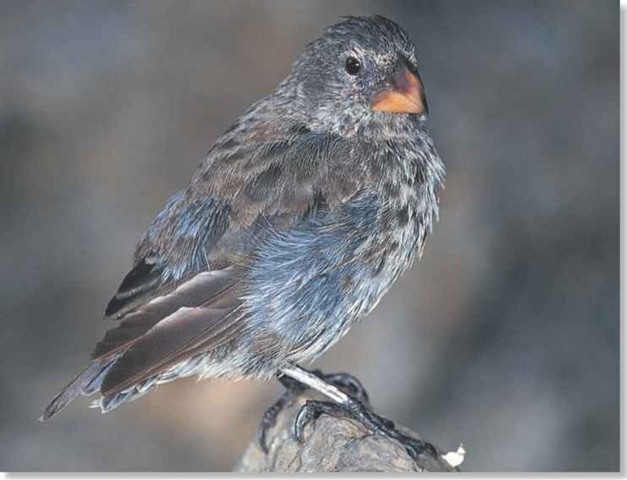ORDER
Passeriform.es
FAMILY
Emberizidae
GENUS
KEY FEATURES
• A genus of small, mostly seed-eating birds that spend the-majority of their time on the ground
• Species differ in body size and-shape-of bill, but are similar in overall shape
• All evolved from a single ancestor that flew to the Galapagos Islands thousands of years ago
WHERE IN THE WORLD!
All six species are confined to the Galapagos Islands in the Pacific Ocean; straddling the equator, the islands lie 600 miles west ” of Ecuador
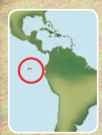
LIFECYCLE
Evolved from a single species to fill several empty feeding niches, the Galapagos ground finches provide a fascinating insight into the evolution of island wildlife.
Habitat
There are 24 islands and numerous smaller islets in the Galapagos archipelago, and ground finches occur on nearly all of them. As their name suggests, the birds spend much of their time on the ground but may also forage in vegetation. On mountainous islands, the finches avoid dense, high-altitude tree cover, and are more common in the coastal scrubland. Elsewhere, except where predators have been introduced, the birds are widespread. Much of the islands’ vegetation is deciduous, coming into leaf and flower in the wet season to provide a short-lived bonanza of food. A few plants, like the Opuntia cactuses, flower and offer food throughout the year
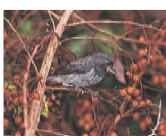
A Rock-hopping Ground finches are common in rocky thickets.
Behavior
Active by day, Galapagos ground finches spend most of their waking hours searching for a variety of food. Outside the breeding season,they often form flocks, sometimes of more than one species. Occasionally, as many as 400 of the birds may gather together
Galapagos ground finches display a fascinating variety of behavior On Hood Island, which has large areas covered by gravel, the cactus finch digs up hidden seeds by pressing its forehead and the bridge of its bill against a large stone and using its feet to push away smaller pebbles. The Wenman Island sharp-beaked finch follows the begging calls of booby nestlings in the hope of scavenging fish scraps from around their nests.
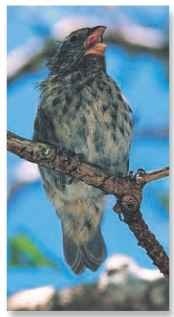
Arboreal antics Ground finches seek refuge from predators like the Galapagos hawk, short-eared owl, barn owl and various snakes.
Conservation
About 97% of the Galapagos Islands is a national park: the area is better protected than almost any other archipelago in the world. Because they are small, ground finches have never been of much interest to humans as food; their greatest threat comes from introduced mammals. Goats cause habitat loss through overgrazing, while cats hunt the finches.
Breeding
Ground finches time their breeding to coincide with the bounty brought by the rains. Within six weeks of the first rainfall, most pairs have already raised their first broods and continue to breed until the rains end. Many small ground finches breed through the dry season, when there is light rain in the uplands where they nest. In the wettest years, populations of ground finches boom.
Males build spherical nests from grasses, usually in the branches of a tree or prickly pear cactus, and help the females line them with grasses, feathers and lichens. While the female incubates the eggs, the male provides her with food. For 14-28 days after leaving the nest, fledglings depend
on their parents-for food. Later they begin to take soft seeds while their bills harden, ready for dealing with tougher varieties.
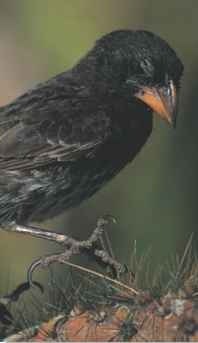
Hard-knock life It may take two years before juveniles can open seeds as efficiently as adults.
• The different bill shapes of the Galapagos ground finches may have inspired-Charles Darwin to write On-The Origin of Species, in-which he-put forth his-theory of evolution by natural selection.
Unlike mainland birds, Galapagos ground finches have no fear of mammal predators, including cats, because none originally occurred on their remote island home.
WINNERS & LOSERS

1 Bound to satisfy…
A sharp-beaked ground finch approaches a blue-footed booby, a bird many times its size.
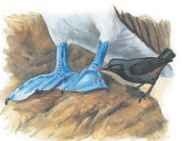
2 Vampire bird…
The finch pecks sharply at the booby’s foot, and eagerly laps up the-blood flowing from the wound.

3 Higher purchase…
Giant tortoises go to places where ground finches abound and adopt a special posture, an invitation…
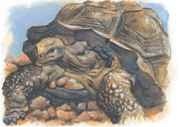
4 Ticking off
…to be cleaned of parasitic ticks under the reptile’s shell. A passing finch soon obliges and tucks in.
Food & feeding
Galapagos ground finches exhibit a diversity of feeding habits that is reflected in the shape, size and curvature of their bills. The large ground finch has a massive, thick bill to crush large, tough seeds, while the small ground finch has a more delicate bill, suited to its diet of soft seeds, berries, nectar and insects.The medium ground finch, midway between the two in body and bill size,eats average-sized seeds. Cactus finches shun seeds and feed mostly on the fruits and flesh of prickly pear and other cacti.
The sharp-beaked finch has the most unusual feeding habits of the Galapagos birds. As well as plant matter and insects, it eats fish scraps dropped by seabirds, breaks open birds’ eggs to get at their contents and even drinks other birds’ blood.
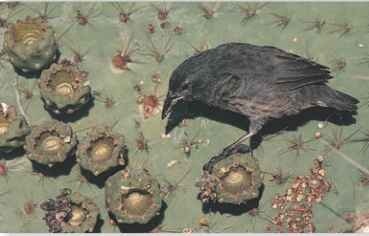
Nectar meal The two species of cactus finch have a longer, more pointed bill than their seed-eating cousins.

PROFILE
Galapagos Ground Finch
Biggest of all the Galapagos finches, the large ground finch has evolved a massive bill to exploit a food source beyond the reach of other species.
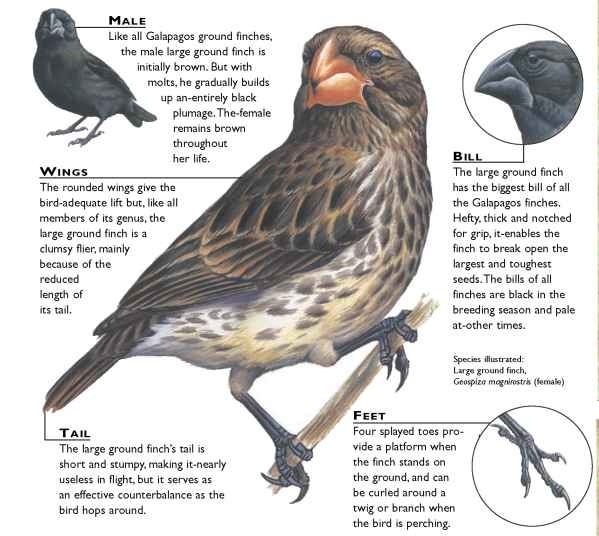
Creature comparisons
Dst certainly related to the large ground finch, the woodpecker finch (Cactospiza pallida) s today placed in a separate genus because of its distinctive appearance and habits.The .woodpecker finch feeds on grubs rather than seeds. Its slightly curved beak pries ^ away bark and decaying wood near the surface but cannot reach larvae that Tto the wood.To overcome this limitation, the bird uses twigs, if stalks or cactus spines to probe into the bore holes and work the grubs into reach, making it one of the world’s few tool-using birds.

Large ground finch

Woodpecker finch
| VITAL STATISTICS | |
| 0.35-1.4 oz., depending on species | |
| Length | Up to 6.6″ |
| Sexual Maturity | 1 year |
| Breeding Season | Jan.-May; some species year-round |
| Number : of Eggs | 1-5, usually 3 |
| Incubation i Period | 11-14 days |
| Fledging Period | About 15 days |
| Breeding Interval | 1 month |
| Typical Diet | Seeds, plant matter; insects and blood from wounds |
| Lifespan | Unknown |
RELATED SPECIES
• There are 6 species in the genus Geospiza, including the medium ground finch, G. fortis, the small ground finch, G. fuliginosa, the large cactus finch, G. conirostris, the cactus finch, G. scandens, and the sharp-beaked ground finch, G. difficilis. Eight other birds are believed to have evolved from the same ancestor. All Galapagos finches are placed in the bunting family, Emberizidae.
